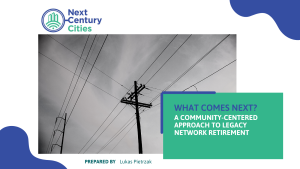By Lukas Pietrzak

Hundreds of millions of people log on to the Internet to access their classes, attend medical appointments, bank, connect with family, and more every day. Each of these users gets online, believing it will be there whenever needed. However, as Internet Service Providers (“ISPs”) increasingly implement plans to discontinue upgrades or fully retire legacy telecommunications networks, customers discover that reliable Internet connections have been interrupted. Some households do not have an affordable alternative.
On February 10th, Next Century Cities released a new paper, What Comes Next? A Community-Centered Approach to Legacy Network Retirement, advocating for the Federal Communications Commission (“FCC”) to revisit consumer-protection safeguards to guide legacy telecommunications network retirement. The report also highlights direct connections between rural electrification in the early 20th century and our modern broadband Internet marketplace.
In 2015, the FCC introduced and approved regulations designed to facilitate safe, transparent, and robust systems to retire or upgrade outdated networks. Those rules promoted open lines of communication between ISPs, customers, and government officials. Recognizing the imbalanced power dynamics in a broadband marketplace with limited competition, the FCC created regulations to ensure that customers would be informed of network transitions and potential service disruptions. Notably, the agency determined that consumers needed the power to challenge decisions and claims.
Consumer-focused safeguards also ensured customers would have access to a reasonable alternative if ISPs discontinued their service. As leaders at all levels of government consider necessary changes to the current broadband landscape, legacy network retirement policies are an excellent place to reinstate guidelines that promote competition, protect public safety, and empower local leaders.
Promoting Competition – Currently, about 88.3 million people across the United States lack access to more than one broadband provider. In these markets, customers are wholly reliant on their incumbent provider. When ISPs decide to suspend service or discontinue repairs on their existing infrastructure, customers need a reliable and easily accessible alternative. New rules should guarantee a reasonable alternative exists for broadband customers and that they are provided adequate time to investigate and adopt a new broadband service.
Protecting Public Safety – While many people use the Internet to consume the latest news or media, many more rely on connections to critical 911 services, telemedicine appointments, and time-sensitive updates from officials. For people in well-connected communities, multiple levels of failsafe measures exist in the event of a wireline broadband outage. However, wireline service is the only option in areas where cellular and satellite connectivity is limited. Re-introducing consumer protection measures from the FCC’s 2015 Retirement Order will help keep the most vulnerable populations connected, especially during emergencies.
Empowering Local Leaders – At the core of every community-based solution is a story. Residents depend on a fast, affordable, and reliable broadband connection to live their everyday lives, and when something goes wrong, they turn to their local officials. Every local leader has a unique role in connecting their community, from city councils to IT professionals and mayors. They have indispensable community-based insights and must be centered in state and national planning. With active steps, the FCC can tap into municipal-level expertise and provide local leaders with legitimate seats at the table to develop policy that shapes the next generation of broadband upgrades and deployment.
The Internet is a living – and constantly evolving – technology at the center of some of society’s most incredible advancements. Every person deserves fast, affordable, and reliable broadband access and the opportunities it offers.
The United States has historically invested in protecting people during intense and rapid technological change, from the Industrial Revolution to the advent of electricity and trans-continental phone access. Legacy network retirement and upgrades to modern technology must be managed with the same detail-oriented care.
Roughly 11.5 million people still rely on outdated, malfunctioning, and sometimes failing legacy telecommunications networks. The FCC can and should take proactive steps to safeguard consumers and increase service options by promoting competition.
Read more from our most recent paper, What Comes Next? A Community-Centered Approach to Legacy Network Retirement.
